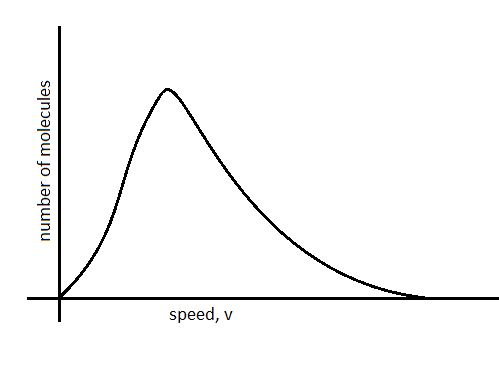
Three closed vessels A, B and C are at the same temperature \[T\] and contain gases which obey the Maxwellian distribution of velocities. Vessel A contains only \[{{O}_{2}}\], vessel B contains only \[{{N}_{2}}\] and vessel C contains a mixture of equal quantities of \[{{O}_{2}}\] and \[{{N}_{2}}\]. If the average speed of \[{{O}_{2}}\] molecules in vessel A is \[{{v}_{1}}\] , average speed of \[{{N}_{2}}\] molecules in vessel B is \[{{v}_{2}}\] then the average speed of \[{{O}_{2}}\] molecules In C will be- (where\[M\]is the mass of oxygen molecule)
(A). \[\dfrac{{{v}_{1}}+{{v}_{2}}}{2}\]
(B). \[{{v}_{1}}\]
(C). \[{{({{v}_{1}}{{v}_{2}})}^{\dfrac{1}{2}}}\]
(D). \[\sqrt{\dfrac{3KT}{M}}\]
Answer
558.6k+ views
Hint: For gases enclosed in a container, the speeds of its molecules vary greatly. It depends on temperature, pressure and mass of the gases. The average speed gives us an idea about the speeds of the majority of the molecules. As \[{{O}_{2}}\] and \[{{N}_{2}}\] molecules are inert their velocities will be independent of each other.
Formula used: \[{{v}_{av}}=\sqrt{\dfrac{3KT}{m}}\]
Complete step by step answer:
Maxwell-Boltzmann distribution gives us the distribution of speeds in molecules of an ideal gas. It is represented by the following graph-

\[{{O}_{2}}\]and\[{{N}_{2}}\] gases are inert gases and cannot react with each other or with other molecules of their kind, therefore their velocities will be independent of each other.
The average of velocity of molecules of gases in a container is given by-
\[{{v}_{av}}=\sqrt{\dfrac{8RT}{\pi m}}\] or \[{{v}_{av}}=\sqrt{\dfrac{3KT}{m}}\]
Here,\[R\] is the gas constant
\[T\] is temperature
\[m\] is mass of the gas
\[K\] is the Boltzmann Constant, its value is \[1.38\times {{10}^{-23}}{{m}^{2}}kg\,{{s}^{-2}}{{K}^{-1}}\]
As the mass of oxygen is given by \[M\], the average velocity of oxygen molecules in vessel C will be-
\[v=\sqrt{\dfrac{3KT}{M}}m{{s}^{-1}}\]
The velocity of oxygen molecules in a mixture of \[{{O}_{2}}\] and \[{{N}_{2}}\] gases in vessel C is \[\sqrt{\dfrac{3KT}{M}}m{{s}^{-1}}\].
So, the correct answer is “Option D”.
Note: As observed from the Boltzwellian distribution, there are very few molecules with high or low speeds. Most molecules possess moderate speeds. As we increase the temperature, the number of molecules with high speeds increase so the graph moves more towards the right. Similarly, as we decrease the temperature, molecules with low speeds decrease so the graph moves more towards the left.
Formula used: \[{{v}_{av}}=\sqrt{\dfrac{3KT}{m}}\]
Complete step by step answer:
Maxwell-Boltzmann distribution gives us the distribution of speeds in molecules of an ideal gas. It is represented by the following graph-

\[{{O}_{2}}\]and\[{{N}_{2}}\] gases are inert gases and cannot react with each other or with other molecules of their kind, therefore their velocities will be independent of each other.
The average of velocity of molecules of gases in a container is given by-
\[{{v}_{av}}=\sqrt{\dfrac{8RT}{\pi m}}\] or \[{{v}_{av}}=\sqrt{\dfrac{3KT}{m}}\]
Here,\[R\] is the gas constant
\[T\] is temperature
\[m\] is mass of the gas
\[K\] is the Boltzmann Constant, its value is \[1.38\times {{10}^{-23}}{{m}^{2}}kg\,{{s}^{-2}}{{K}^{-1}}\]
As the mass of oxygen is given by \[M\], the average velocity of oxygen molecules in vessel C will be-
\[v=\sqrt{\dfrac{3KT}{M}}m{{s}^{-1}}\]
The velocity of oxygen molecules in a mixture of \[{{O}_{2}}\] and \[{{N}_{2}}\] gases in vessel C is \[\sqrt{\dfrac{3KT}{M}}m{{s}^{-1}}\].
So, the correct answer is “Option D”.
Note: As observed from the Boltzwellian distribution, there are very few molecules with high or low speeds. Most molecules possess moderate speeds. As we increase the temperature, the number of molecules with high speeds increase so the graph moves more towards the right. Similarly, as we decrease the temperature, molecules with low speeds decrease so the graph moves more towards the left.
Recently Updated Pages
Master Class 11 Economics: Engaging Questions & Answers for Success

Master Class 11 English: Engaging Questions & Answers for Success

Master Class 11 Social Science: Engaging Questions & Answers for Success

Master Class 11 Biology: Engaging Questions & Answers for Success

Class 11 Question and Answer - Your Ultimate Solutions Guide

Master Class 11 Business Studies: Engaging Questions & Answers for Success

Trending doubts
What is meant by exothermic and endothermic reactions class 11 chemistry CBSE

1 Quintal is equal to a 110 kg b 10 kg c 100kg d 1000 class 11 physics CBSE

What is periodicity class 11 chemistry CBSE

Explain zero factorial class 11 maths CBSE

What is a periderm How does periderm formation take class 11 biology CBSE

What are porins class 11 biology CBSE




